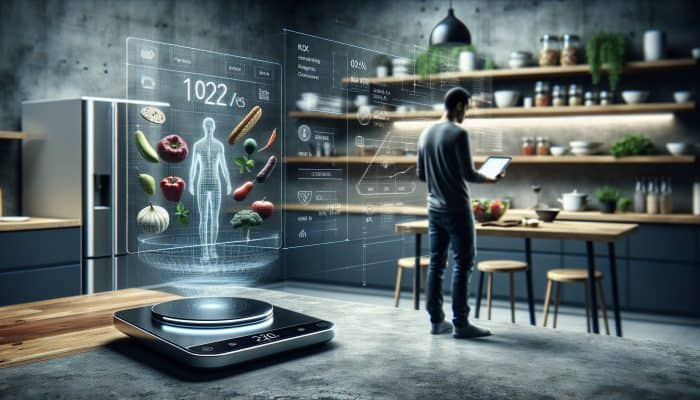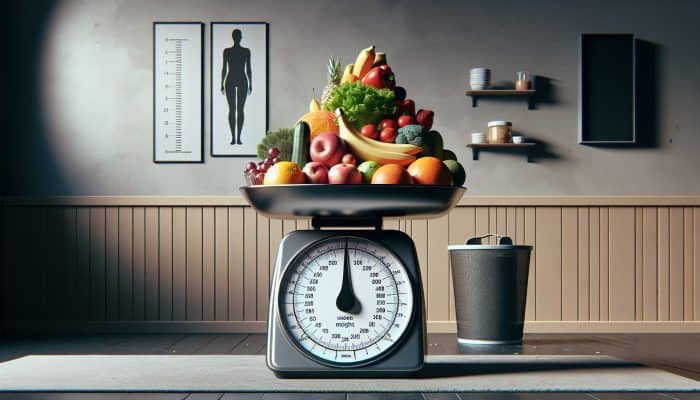Maximize Your Health Benefits with Advanced Portion Control Technology
Understanding the Impact of Portion Control Technology on Healthy Eating

Portion control technology represents a groundbreaking method for managing food intake, employing digital tools and smart devices to foster healthier eating habits. This innovative technology includes a variety of solutions, such as smart kitchen scales and mobile applications, designed to empower individuals in taking control of their nutritional habits. By ensuring appropriate portion sizes are consumed, users can make informed dietary choices that promote a balanced and health-focused lifestyle.
Incorporating technology for portion control into daily routines equips users with the ability to accurately monitor their food intake. For example, advanced smart scales can seamlessly connect to applications that track caloric consumption, providing invaluable insights into personal dietary patterns. This integration not only enhances self-awareness but also instills a sense of accountability, making the journey toward achieving health objectives simpler and more effective. As technology continues to evolve, the opportunities for utilizing these tools to enhance health outcomes are vast and promising.
Addressing the UK Obesity Epidemic with Strategic Portion Control
The rising obesity epidemic in the United Kingdom poses a significant public health concern, with a substantial segment of the population categorized as overweight or obese. Portion control stands out as a crucial strategy for tackling this pressing issue. By understanding proper serving sizes and consciously making healthier food choices, individuals can effectively reduce caloric intake and improve their overall dietary quality.
Research shows that larger portion sizes correlate with overeating, making it essential for UK residents to implement effective portion control strategies. Promoting healthier eating habits through technology can significantly contribute to this initiative, motivating users to reassess their meal practices. As awareness of the significance of portion sizes increases, the role of technology for portion control becomes ever more vital in facilitating long-lasting behavioral changes.
Leveraging Technology for Effective Portion Management
The convergence of technology and nutrition offers numerous advantages for those looking to manage their portion sizes effectively. Smart kitchen gadgets, mobile applications, and wearable devices collectively provide innovative solutions for monitoring food intake, enabling users to make educated decisions about their meals while adhering to dietary guidelines and achieving personal health goals.
For instance, smart scales allow users to accurately weigh their food, while mobile applications store nutritional data and offer instant feedback on portion sizes. This immediate access to information fosters a greater understanding of personal eating behaviors over time, promoting a more mindful approach to nutrition. By integrating technology into their everyday routines, UK residents can deepen their comprehension of portion control and ultimately enhance their health outcomes.
Exploring the Comprehensive Benefits of Portion Control Technology

The benefits of utilizing technology for portion control are extensive, particularly for individuals seeking to improve their health and well-being. A key advantage is enhanced weight management, as users learn to identify appropriate portion sizes and make healthier selections. This is particularly relevant in the UK, where rising obesity rates necessitate effective strategies to combat this health crisis.
Moreover, leveraging technology for portion control can lead to decreased food waste. By measuring food portions accurately, individuals can reduce leftovers and ensure that all prepared food is utilized. This not only alleviates personal financial burdens by cutting down on waste but also positively impacts environmental sustainability. Ultimately, incorporating technology into portion control practices can lead to improved health outcomes, making it a worthwhile investment for individuals across the UK.
Exploring Innovative Smart Kitchen Gadgets for Optimal Portion Control
Revolutionizing Portion Management with Cutting-Edge Smart Scales and Measuring Devices
Smart scales and measuring instruments have transformed the way portion control is approached by individuals in the UK. These devices deliver precise measurements, enabling users to manage their food intake accurately. Unlike traditional scales, smart scales often feature advanced technology that connects with mobile applications, allowing users to track their caloric consumption effortlessly.
Equipped with built-in nutritional databases and connectivity to health applications, smart scales empower users to make well-informed decisions about their meals. For example, while preparing a recipe, users can weigh ingredients and receive real-time feedback on portion sizes and caloric content. This immediate access to information encourages more mindful eating practices, aligning with health goals and dietary restrictions.
The increasing popularity of smart scales in the UK underscores the growing awareness of the importance of portion control. As consumers become more health-conscious, investing in these gadgets has become a common practice in many households. By utilizing this technology, individuals can gain a deeper understanding of their eating habits and make necessary adjustments, ultimately leading to healthier lifestyle choices.
Enhancing Meal Preparation with State-of-the-Art Connected Kitchen Appliances

Connected kitchen appliances are transforming the landscape of healthy cooking in the UK. Smart fridges, ovens, and various devices come equipped with features that promote portion control while simplifying meal preparation. For example, smart ovens can provide guidance on cooking times and temperatures based on portion sizes, ensuring that meals are both delicious and appropriately portioned.
Furthermore, many connected appliances can synchronize with mobile applications, allowing users to plan meals and effectively monitor their nutritional intake. This integration creates a seamless cooking experience, where individuals can effortlessly keep track of their portion sizes while preparing nutritious recipes. The convenience provided by smart appliances encourages healthier choices, reducing dependence on takeaways and processed foods.
In the UK, where busy lifestyles often lead to dietary shortcuts, connected kitchen appliances offer innovative solutions. By advocating for portion control and healthy cooking practices, these gadgets help individuals cultivate a more balanced approach to eating, ultimately contributing to improved health outcomes.
Maximizing the Benefits of Integration with Health Apps
The seamless integration of kitchen gadgets with health applications greatly enhances the user experience regarding portion control. Many smart kitchen devices connect with popular health apps, allowing users to track their food intake effortlessly. This integration provides a comprehensive strategy for managing portion sizes and nutritional intake, streamlining the journey toward achieving health goals.
For instance, when users weigh their food on a smart scale, the data can be automatically uploaded to a connected health app. This eliminates the need for manual entry, providing real-time feedback on caloric consumption. Users can also access portion size guides and nutritional information through these applications, empowering them to make informed decisions while cooking or dining out.
In the UK, the availability of such integrated systems has simplified the adoption of healthier eating habits. The convenience of having all relevant data in one place empowers users to track their progress and adjust their portion sizes as needed. Overall, the synergy between kitchen gadgets and health apps promotes a more mindful approach to eating, leading to improved health outcomes for individuals nationwide.
Harnessing Mobile Applications for Effective Portion Control
Top Mobile Apps Transforming Portion Control Practices in the UK
Mobile applications have become essential tools for individuals seeking to manage their portion sizes effectively. In the UK, popular apps such as MyFitnessPal and Lifesum have gained substantial traction due to their user-friendly interfaces and comprehensive features. These applications empower users to track their food intake, set health objectives, and monitor their progress over time.
MyFitnessPal, for instance, boasts an extensive database of food items, making it easy for users to log their meals and accurately track their portion sizes. With features like barcode scanning and meal suggestions, the app simplifies the process of tracking nutritional intake, thereby encouraging adherence to portion control practices. Additionally, Lifesum offers personalized meal plans and portion size recommendations tailored to individual dietary preferences, increasing its appeal to users in the UK.
As the demand for health-focused applications continues to surge, the availability of these tools in the UK reflects a growing awareness of the significance of portion control. By harnessing technology, individuals can take charge of their nutritional habits and work toward achieving healthier lifestyles.
Exploring Features and Functionalities of Portion Control Applications
The efficacy of mobile apps for portion control lies in their rich features and functionalities. Many applications offer barcode scanning, allowing users to quickly log food items by simply scanning the packaging. This feature not only saves time but also guarantees that users receive accurate nutritional information for the foods they consume.
Meal logging capabilities are another essential aspect of these apps, enabling users to document their food intake and effectively monitor portion sizes. With the ability to create custom meals and save frequently consumed items, users can streamline their tracking process, making it easier to adhere to their dietary goals. Additionally, many apps feature portion size guides and visual aids that help users understand what constitutes an appropriate serving.
In the UK, user experiences with these apps have been predominantly positive. Reviews frequently highlight the ease of use and effectiveness in managing portion control, with many individuals reporting significant improvements in their eating habits. By incorporating features that cater to user needs, these applications empower individuals to take control of their nutrition and make informed decisions.
Real-Life User Experiences and Testimonials on Portion Control Applications
User experiences with portion control apps in the UK provide valuable insights into their effectiveness and functionality. Many individuals have shared transformative results, detailing how these tools have heightened their awareness of their eating habits. The intuitive design and user-friendly interfaces of apps like MyFitnessPal and Lifesum make them accessible to a diverse range of users, from novices to seasoned health enthusiasts.
Reviews often emphasize the motivation derived from tracking progress within the app. Users can set personal goals, monitor their progression, and connect with a community of like-minded individuals for mutual support. This social dimension fosters accountability, motivating users to stay committed to their portion control practices.
Moreover, many users appreciate the educational aspect of these apps, as they provide insights into nutritional content and portion sizes. By equipping individuals with knowledge, these applications contribute to a deeper understanding of healthy eating behaviors, ultimately leading to improved health outcomes across the UK.
Boosting Portion Control Through Integration with Other Health Technologies
The integration of mobile apps for portion control with other health technologies significantly enhances their effectiveness. Numerous apps can sync with fitness trackers and smart scales, creating a comprehensive ecosystem for health management. This interconnectedness enables users to monitor their food intake and physical activity in one place, offering a holistic approach to health.
For example, when users log their meals in a portion control app, the data can reflect in their fitness tracker, providing insights into how dietary choices impact their overall activity levels. This synergy encourages users to make more informed decisions regarding both their food intake and exercise routines, leading to a more balanced lifestyle.
In the UK, the growing accessibility of these technologies has motivated individuals to adopt healthier habits. The ability to simultaneously track food intake and physical activity empowers users to take control of their health and well-being. As technology advances, the potential for further integration within health management systems will only enhance the effectiveness of portion control practices.
Adopting Wearable Technologies for Enhanced Portion Control
Utilizing Smartwatches and Fitness Trackers for Healthier Eating Habits
Smartwatches and fitness trackers have become invaluable tools in the pursuit of effective portion control. In the UK, these devices not only monitor physical activity but also provide features to track food intake, giving users real-time feedback on their dietary choices. This integration fosters adherence, allowing individuals to achieve their health goals more effortlessly.
For instance, many fitness trackers enable users to log their meals and snacks directly through connected mobile apps. This seamless integration allows individuals to track their caloric intake easily and adjust their portion sizes accordingly. Furthermore, some wearables offer reminders to keep users on track, prompting them to make healthier choices throughout the day.
As UK residents become increasingly health-conscious, the popularity of smartwatches and fitness trackers continues to grow. These devices empower individuals to take control of their nutrition, cultivating a more mindful approach to eating. By leveraging technology, users can improve their overall health and well-being while effectively managing their portion sizes.
Integrating Wearable Devices with Diet Plans for Optimal Portion Control
The capability of wearable devices to integrate with popular diet plans significantly enhances their effectiveness in promoting portion control. Many smartwatches and fitness trackers offer compatibility with established dietary programs, allowing users to customize their food intake based on specific guidelines. This synergy between technology and nutrition creates a streamlined approach to health management.
For instance, individuals following low-carb or ketogenic diets can receive tailored portion size recommendations directly from their wearables, ensuring their meals align with their dietary needs. This level of personalization enables users to make informed decisions regarding their food choices, ultimately leading to better adherence to their diet plans.
In the UK, the increasing availability of these technologies has encouraged more individuals to adopt healthier eating habits. By providing users with the necessary tools to manage their portion sizes effectively, wearables play a pivotal role in promoting overall health and well-being.
Utilizing Earables for Comprehensive Health Monitoring and Portion Control
The benefits of wearable technology for health monitoring extend beyond fitness tracking, encompassing effective portion control as well. Continuous monitoring and feedback from smartwatches and fitness trackers enable users in the UK to maintain their portion sizes and gain a clearer understanding of their eating habits. This heightened awareness is essential for individuals striving to achieve specific health goals, such as weight loss or improved nutritional intake.
For example, wearables can track trends in food consumption, revealing patterns that may lead to overeating or unhealthy eating behaviors. By identifying these trends, users can make informed adjustments to their portion sizes, fostering a more mindful approach to eating. Additionally, many devices provide insights into how dietary choices affect overall health, giving users a comprehensive view of their well-being.
The adoption of wearable technology for health monitoring has gained popularity in the UK, with numerous individuals reporting significant improvements in their portion control practices. By leveraging these devices, users can acquire a deeper understanding of their dietary habits and implement meaningful changes toward healthier living.
The Revolutionary Role of AI and Machine Learning in Portion Control
Personalized Portion Size Recommendations Through AI Technology
Artificial intelligence (AI) and machine learning have the potential to transform how individuals in the UK manage their portion sizes. By analyzing personal health data and dietary preferences, these technologies can provide customized portion size recommendations tailored to users' unique needs. This level of personalization enhances the effectiveness of portion control strategies, empowering individuals to make informed choices regarding their food intake.
For example, AI-powered applications can assess factors such as age, weight, activity level, and health objectives to generate ideal portion sizes for users. This personalized approach ensures that individuals receive recommendations aligned with their specific dietary requirements, promoting a more effective strategy for weight management and overall health.
In the UK, the integration of AI and machine learning into portion control practices signifies a substantial advancement in health technology. As consumers increasingly seek personalized solutions for their dietary needs, the potential for these technologies to enhance health outcomes is immense.
Utilizing Predictive Analysis to Understand Eating Patterns
Predictive analysis powered by AI can significantly enhance the comprehension of eating habits among UK residents. By examining patterns in food consumption, these technologies can identify trends and behaviors that may result in poor dietary choices. This information enables users to proactively adjust their portion sizes, promoting healthier eating practices.
For instance, if an AI-driven application detects that a user tends to overeat during specific times of the day, it can offer tailored suggestions to help them manage their portion sizes more effectively. This proactive approach to portion control allows individuals to take charge of their eating behaviors, ultimately leading to improved health outcomes.
As AI technology advances, its application in portion control is likely to expand, providing users in the UK with even greater insights into their dietary habits. By leveraging predictive analysis, individuals can foster a deeper understanding of their eating behaviors, encouraging a more mindful approach to nutrition.
Enhancing Smart Home Systems with AI-Driven Portion Control
The integration of AI-driven portion control technology with smart home systems represents a groundbreaking advancement in health management. By connecting devices such as smart fridges, ovens, and meal planning applications, users can create a cohesive ecosystem that promotes healthy eating habits. This interconnectedness not only simplifies meal preparation but also strengthens portion control strategies.
For instance, a smart fridge can suggest portion sizes based on available ingredients, while an AI-driven meal planning app can recommend recipes that align with a user’s dietary preferences. This level of integration equips users in the UK with the necessary tools to make healthier choices while streamlining their cooking experience.
As smart home technology evolves, the potential for enhanced portion control practices will only increase. By utilizing these advancements, individuals can take charge of their nutrition and develop healthier eating habits that contribute to improved overall health.
AI-Driven Nutritional Guidance for Informed Eating Decisions
AI-driven nutritional guidance offers personalized insights into portion sizes and dietary needs, empowering users in the UK to make informed decisions regarding their food intake. By analyzing individual health data, these technologies can deliver tailored advice that aligns with users’ specific goals, whether related to weight loss, muscle gain, or overall wellness.
For example, AI applications can recommend portion sizes tailored to users’ dietary restrictions, ensuring they receive essential nutrients while adhering to their health objectives. This personalized approach fosters a deeper understanding of nutrition, enabling individuals to make more informed choices about their meals.
The integration of AI-driven nutritional guidance into portion control strategies signifies a significant advancement in health technology. As more individuals in the UK seek personalized solutions for their dietary needs, the potential for these technologies to enhance health outcomes is boundless.
Utilizing Machine Learning to Minimize Food Waste
Machine learning technology plays a critical role in reducing food waste by predicting optimal portion sizes and consumption patterns. In the UK, this technology can assist households and businesses alike in minimizing waste by providing insights into how much food to prepare based on historical data and consumption trends.
For example, machine learning algorithms can analyze eating behaviors to suggest appropriate portion sizes for upcoming meals. By accurately predicting food consumption, users can avoid over-preparing meals that lead to waste, ultimately benefiting both their finances and the environment.
As awareness of food waste issues escalates in the UK, incorporating machine learning into portion control practices provides an innovative solution. By leveraging technology, individuals can adopt more sustainable eating habits while effectively managing their portion sizes.
Exploring Educational Resources and Workshops for Mastering Portion Control
Engaging in Online Courses and Tutorials on Portion Control Techniques
Online courses and tutorials have emerged as valuable resources for individuals aiming to master portion control techniques. In the UK, numerous platforms offer educational content that integrates technology, providing practical applications for effectively managing food intake. These resources often cover essential concepts, including understanding portion sizes, nutritional content, and the impact of eating behaviors on overall health.
By accessing these online courses, users can learn at their own pace and develop a deeper understanding of portion control. Many programs include interactive elements, such as quizzes and assignments, to reinforce learning and encourage application in real-life situations. This engagement enhances the educational experience, empowering users to adopt healthier eating habits.
As technology continues to play a pivotal role in health education, the availability of online resources in the UK is expected to expand. By embracing these tools, individuals can take control of their nutrition and cultivate a more mindful approach to portion control.
Participating in In-Person Workshops and Seminars for Practical Learning
In-person workshops and seminars focused on portion control are essential for fostering a comprehensive understanding of healthy eating practices in the UK. These events often provide hands-on learning experiences, allowing participants to engage with experts in the field and gain valuable insights into effective portion control strategies.
During workshops, attendees can learn practical techniques for measuring portion sizes, understanding nutritional content, and applying technology to enhance their eating habits. The interactive nature of these sessions fosters a supportive community, encouraging participants to share their experiences and learn from one another.
As demand for education on portion control continues to rise, in-person workshops will play a crucial role in equipping individuals with the knowledge and skills necessary to make informed dietary choices. By embracing these opportunities, participants can take significant steps toward improving their health and well-being.
Utilizing Educational Apps and Tools for Interactive Learning
Educational apps and digital tools in the UK provide interactive learning experiences that assist users in mastering portion control techniques. These applications often feature games, quizzes, and visual aids that make learning about nutrition engaging and accessible. By leveraging technology, these tools can help users develop a deeper understanding of portion sizes and healthy eating habits.
For instance, some educational apps provide interactive meal planning tools that enable users to experiment with various portion sizes and ingredient combinations. This hands-on experience cultivates a practical understanding of how portion control impacts overall health. By integrating these educational resources into daily routines, individuals can achieve improved eating behaviors and better health outcomes.
As technology continues to evolve, the availability of educational apps and tools in the UK is expected to expand, providing users with even more resources to master portion control. By embracing these innovative solutions, individuals can take charge of their nutrition and strive towards healthier lifestyles.
Addressing Common Questions About Portion Control Technology
What does portion control technology entail?
Portion control technology encompasses a variety of digital tools and smart devices aimed at helping individuals manage their food intake and promote healthier eating habits.
Why is portion control significant in the UK?
Portion control is crucial in the UK for combating obesity and fostering a healthier lifestyle, as many individuals struggle with proper portion sizes and tend to overconsume.
How can technology aid in portion control?
Technology offers solutions such as smart scales, connected kitchen appliances, and mobile apps that efficiently track food intake and portion sizes.
Which mobile apps are popular for portion control in the UK?
Popular applications in the UK include MyFitnessPal and Lifesum, which assist users in tracking their food intake and managing portion sizes.
What features should users expect from these portion control apps?
These apps typically provide features such as barcode scanning, meal logging, and portion size guides to support users in managing their intake.
How can wearable technology contribute to portion control?
Wearable technology can monitor food intake, send reminders, and integrate with diet plans to aid users in maintaining healthy portion sizes.
What is the role of AI in portion control strategies?
AI can deliver personalized portion size recommendations, predict eating habits, and provide tailored nutritional guidance based on individual health data.
Are there educational resources available to help me master portion control?
A variety of online courses, workshops, and educational apps in the UK teach effective portion control techniques.
How does machine learning contribute to reducing food waste?
Machine learning can predict optimal portion sizes and consumption patterns, assisting users in preventing meal over-preparation and minimizing food waste.
What benefits can users expect from utilizing portion control technology?
Benefits include improved weight management, reduced food waste, and enhanced overall health outcomes for users in the UK.
Connect with us on Facebook!
The Article Tech for Portion Control: Smart Eating Solutions Was First Published On https://acupuncture-frome.co.uk
The Article Portion Control Tech: Innovative Solutions for Smart Eating Was Found On https://limitsofstrategy.com

